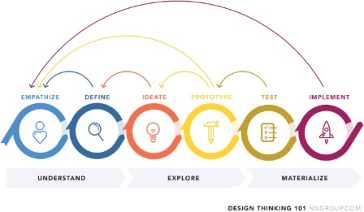Design Thinking, Analytical Thinking
Adapted from the article originally written by Jinjin Qi
for the Cabrera's Cornell University, System Thinking in Public Affairs Course
Summary
Design Thinking is an approach that used for practical and creative problem-solving. It not only works for designers but also helps people who aren't trained as designers to use creative tools to deal with challenges they meet in works and lives. Tim Brown, the CEO of IDEO, describes design thinking as a human-centered approach to innovation that draws from the designer's toolkit to integrate the needs of people, the possibilities of technology, and the requirements for business success. My estimation is that design thinking is in the second wave as we can see the rise of human-centered design and design-centered business management. This is not a static idea and it develops all the time.
Core Principles & Main Steps-----
The most important feature of design thinking is a human- centered core. Design thinking focusses on understanding people’s need.
A five-phase description of the design innovation process is described as: (re)defining the problem, needfinding and benchmarking, ideating, building, testing (Plattner et al., 2011). The Hasso-Plattner Institute of Design at Stanford, which is at the forefront of applying and teaching design thinking, gives four principles of design thinking:
- The Human Rule – Design is inherently
- The Ambiguity Rule – Problems are ambiguous and open to interpretation. Removing ambiguity limits
- The Redesign Rule – Design thinking posits that all design is re-design. Humans are constantly looking for new ways to solve variations on old
- The Tangibility Rule – The best way to communicate design ideas is through tangible ideas and Tangible ideas and products allow improved dialogue, understanding, and problem-solving.
Based on the above principles, five-stage model is proposed:
- Empathize – Understanding the needs of those you’re designing
- Define – Construct a point of view that is based on user needs and
- Ideate – Challenge assumptions and come up with innovative solutions (brainstorming is a useful tool).
- Prototype – Build a representation of one or more of your ideas to show to
- Test – Return to your original user group and testing your ideas for
From the picture below, we can see it is not a linear progress because of the non-linear nature of design thinking. It may be thought of as a system of overlapping spaces rather than a sequence of orderly steps: inspiration, ideation, and implementation (Brown, 2008).

Example
One application that we can feel and experience in our daily life is in computer science. Design thinking is central to recent conceptions of software development in general (Ralph, 2015). Most APPs that are installed on our smartphones benefit from design thinking a lot. How do those creative APPs fit our needs? Take a popular English-reciting APP in China as an example. According to the design thinking model, designers should recognize students’ needs in reciting English words. As it is usually a boring task, designers should find a method that makes it interesting and efficient. Brainstorming then begins, and they also need to build prototypes that embrace these creative ideas. They will invite some users to test. Designers interpret the information received from tests and see what step they may need to go back to in their design thinking process. In this process, prototypes are combined, expanded on, or discarded based on users’ insights. All these efforts give birth to a successful and popular APP. People love it because it knows what they really want! Reciting English words is no longer horrible!
-----Pros and Cons-----
Pros: significantly reduces time-to-market; cost savings; improves customer retention and loyalty; fosters innovation; can be applied company-wide.
Cons: design thinking is quite different from analytical thinking. Decisions made through design thinking are based on what potential customers really want, not just historical data or evidence. Intuition plays a vital role here. The shortcoming can be oversimplifying the design process and trivializing the role of technical knowledge and skills (Kolko, 2018).
References
- Plattner, H., & Meinel, C., & Leifer, L. (2011). Design thinking: understand, improve, apply. Understanding innovation.
- Brown, T. (2008). Design thinking. Harvard Business Review
- Ralph, P.(2015). The Sensemaking-Coevolution- Implementation Theory of software design. Sci. Comput. Program., 101, 21-41.
- Kolko, J. (2018). The divisiveness of design thinking. Interactions.
